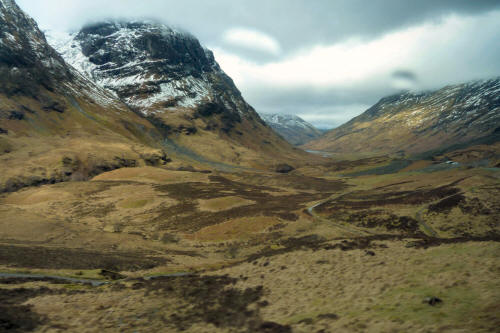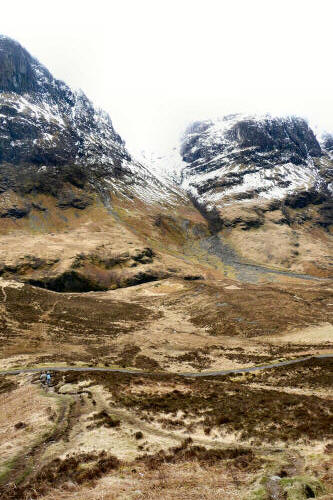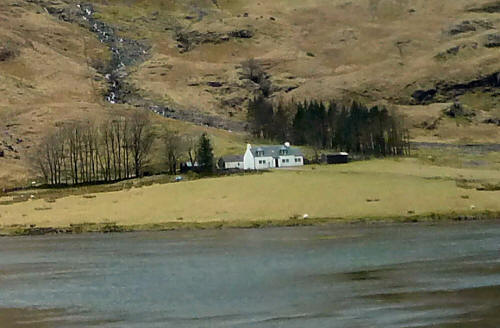Day Three
We had the early breakfast today at 7:45
a.m. We were going to have a long day and needed to get away from the
hotel and on the road. Using a Scottish term, the day was dreich –
dreary and gloomy. It was rainy and foggy as we took the ferry across
the loch. Kevin played some soft Scottish music for our Sunday morning.
We passed a huge boulder with a rectangle cut into it, a pulpit from
which John Knox had preached. The mossy rocks and tree trunks in the
woods were gorgeous, but the coach windows had glares on them and too
much rain for photos to be possible. I told Jim I would like to tour
this area in a car so I can stop and take photos whenever I see
something interesting. He really is worse than I am with taking photos
and pulls over frequently when travelling. There are so many lovely
scenes in this part of Scotland, but one can’t drive the entire world
photographing it, so these tours are the next best thing.

I was fascinated by the soft green hairy
moss I saw growing on so many of the trees. I asked if it had a name and
was told by Kevin and all three tour guides on the coach that it was
“just lichen.” It must be a special kind of lichen. It looks as if it
would be soft to the touch, but when another woman on the tour, who also
was fascinated by it, pulled some from a tree, we discovered it to be
coarse. I have since checked up to find that it is not harmful to the
trees. It even grew on the conifers! Kevin told us a story about
farkling haggis. Go on the tour to hear it. I’m not sure I quite
understand the jist of it! The history mentioned this morning involved
Argyll Bute, the 1688 Battle of Killiecrankie, the Grahams (Bonnie
Dundee), and Jacobites, this being the first of the seven rebellions. We
passed Glen Orchy and the River Orchy then Loch Tulla, where Sir Ian
Fleming, creator of James Bond, grew up.
Then we arrived at Rannoch Moor, a very
green boggy area in summer, but with snow in the ridges, more like a
moon landscape with a few lochs scattered around. It had a haunting,
unreal quality to it. There is a ski area near the moor, and the area is
represented in Parliament by the MP Charles Kennedy, former leader of
the Liberal party. We took photos through the windows of the coach and
hoped to get a few good ones to show the intriguing scene.

From Rannoch Moor we went on to Glencoe,
infamous for the massacre of the McDonalds by the government troops lead
by Robert Campbell of Glenlyon in February 1692. Thirty-eight people
were killed outright and others died trying to escape through the snow.
Some did manage to escape to the Stewart of Appin lands. The Campbells
had accepted the hospitality of the McDonalds for several days before
they massacred them, the breach of trust making the killing even worse
in the eyes of the world. For a complete telling of the story of
Glencoe, I suggest you read “Glencoe” by John Prebbles, who also has
written the books “Highland Clearances” and “Culloden.” I have seen
photos of the glen taken in the summer when it is green and
breathtakingly beautiful. It has a great dramatic and majestic
appearance in winter too. Jim told me to be an annoying tourist and ask
Kevin the names of the Three Sisters, the mountains of the glen. Kevin
hesitated, said he didn’t know then quickly said they were Charity,
Faith and Hope!!
As we travelled toward Glencoe village, we
saw Scottish black-faced sheep along the road. Kevin told us there is a
hotel in the village that has a sign saying “No Campbells Allowed.” In
Loch Leven there are three small islands, one holding the graves of the
slaughtered McDonalds. One of the guide tourists sitting near us said
the islands have names, but he could only remember Destiny as one of
them. Sir Jimmy Saville lives in a cottage in the glen and often sits on
his patio and waves at the passing vehicles.
We stopped for tea at the Ballachulish Hotel
where the scones were freshly baked before our arrival. Yummy! In
reaching the hotel, we had to pass over a bridge that had been cursed as
it was being built, the curse to go into effect once it was completed.
For this reason, the bridge has never been completed. One rivet has been
left out! We continued on past Loch Linnie, and signs began to appear in
both English and Gaelic. We saw Stalker Castle on its island in the loch
and heard the history of Somerled, Lord of the Isles, and his sons who
became the chiefs of various clans. The late Scottish author Nigel
Tranter wrote a wonderful book about Somerled among his many other books
about people in Scottish history. We passed the sign for the turnoff to
the Lismore Ferry, Loch Etive, then Dunstaffnage Castle, a ruined
McDougall castle, before arriving in Oban.
_small.jpg)
I was briefly in Oban in 2000 just long
enough to get off the ferry from Mull and onto the Globus coach, so I
was looking forward to exploring the town. It has a population of
between 7,000-8,000 but most of the shops are along one long street so
can be discovered quickly. A huge folly designed like the Roman
Coliseum, looms over the town from the hillside above. It is called
McCaig’s Folly and was built to give employment to local people.
However, it was never completed as McCaig died. As it was Sunday, most
of the shops were closed. Jim wanted me to see an Art Deco hotel, The
Regent, where some of the Cosmos tours have stayed, and the pub next
door that he has frequented on occasion! We had seen a sign offering a
special on a fish and chips lunch at one of the restaurants, so we went
for that – excellent – before heading back to the coach. The stay in
Oban is normally four hours, but with most things closed, Kevin had
offered us an option of a trip to Seil Island a bit farther down the
coast. At a cost of £4.50, it was a steal. One couple decided to stay in
Oban; the rest of us went to Seil Island.
_small.jpg)
On the way, we passed Loch Firkin, where the
bodies of Scottish kings were taken by boat out into the Atlantic and
over to Iona for burial. We also passed the white cottage used in the
filming of “Ring of Bright Water,” the story of Gavin Maxwell and his
otter. The trees in this area were covered in the green lichen. Upon
arrival at Seil Island, an arched bridge actually spans part of the
Atlantic Ocean. Kevin stopped to allow those who wanted to walk over the
bridge to get out of the coach then he drove slowly over the bridge so
they could photograph the coach on the bridge from the other side. The
inn at the other side of the bridge is called Tigh An Truish, the inn of
the trousers. When the Scottish dress of the kilt was banned after
Culloden, the men on the island wore the kilt while on the island, but
they kept trousers at the inn so they could change into them before
going to the mainland. Kevin pointed out the house where Princess
Diana’s mother, Mrs. Kidd-Shand, lived in seclusion until her death a
few years ago.
Slate mining was the business here and we
passed rows of slate miners’ cottages on our way into the little
village. It was so misty, the mist moving sideways as we drove along. We
parked near a gift shop displaying the art work of the owner’s father.
Some people had tea or coffee there. Jim and I walked to the Oyster Bar
Brewery so he could have a Jura whisky while I had my usual Diet Coke.
He told me about George Orwell writing “1984” on Jura in 1948. We walked
around the village and onto the dock where lobster pots were piled then
returned to the coach to continue our day’s journey.
I noticed some of the mountains were
beginning to turn green, albeit a very pale green, and several trees had
tiny pink buds on them. I even saw one yellow rhododendron in bloom and
very gorgeous too. Spring is not too far off in this part of the
highlands. The road was not very smooth in places, Jim said because it
is built over marshy ground. We saw some deer in one field as we neared
Inverawe at the mouth of the River Awe. There were holiday cottages in
this area.

Kevin told us about the Pass of Brander
where the McDougalls had set up an ambush for Robert Bruce, but Bruce
heard about it and ambushed the ambush. Nigel Tranter wrote a very
detailed book about the life of Robert Bruce if you want to know more
about him. We passed a hollow mountain where you can tour inside in a
mini bus. We passed a trout fishing farm on Loch Awe. Kevin was playing
soft Scottish music for this lazy Sunday afternoon group. I was watching
the burns outside the window. Sometimes the water skips and jumps over
stones; sometimes it roils; sometimes it rushes playfully, twisting and
turning, bubbling and gurgling. At other times the water is very still.
From shallow streams to raging burns and powerful waterfalls, you can
see it all on this route. There is something mesmerizing about water,
isn’t there?
We arrived back at the Inveruglas viewpoint
where we got onto the ferry for the trip back to the hotel. A very cold
wind was blowing and the loch rippled from the wind. Jim and I sat in
the small lounge at the hotel for awhile watching the news on TV. The
no-fly zone over Libya had been declared and bombing was beginning.
After dinner a man and wife team entertained then pleasantly tired, Jim
and I snuggled into our bed for a good night’s sleep.

